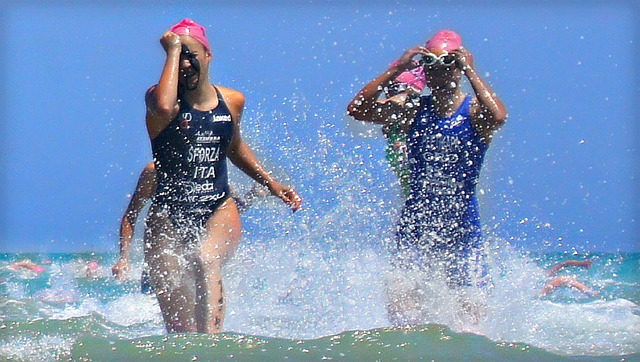What is the Progressive Overload Training Principle?
The Progressive Overload Training Principle utilizes the human body’s physiological ability to adapt to increasing work loads to improve physical conditioning.
What does this mean? It means that the human body is designed to adapt to the demands that are placed upon it.
This is Fantastic news! Because it means that your body is capable of doing amazing feats. Feats that may seem unimaginable to you right now in this moment, but are certainly reachable with the right mindset, time and consistent effort.
Even if you have never swum a mile without stopping before, you can use the power of your mind and progressive overload training to build up your conditioning to achieve that benchmark.
Heck, an adult who doesn’t even know how to swim can learn to do it, as long as they don’t have any physiological contraindications for swimming. They can learn the swim strokes and teach their body the movements so they become automatic and master the skill.
All it takes is an affirming mental approach, time, work “load”, recovery and consistent effort.
LOAD → RECOVER → ADAPT
What does “LOAD” mean?
For the purposes of this article, let’s talk about three fundamental parameters of what exercise “Load” is; Intensity, Volume and Frequency. Exercise Load can also be broken down further into the types of load that you are applying, the tissues that are loaded and the variability of that load, but we’ll stick with the three fundamentals for now.
Unpacking the three fundamentals of work “LOAD”, it looks a little like this…
1. Intensity – The amount of physical effort expended during an exercise or a training session.
You can gauge your exercise intensity by tracking your heart rate and VO2 Max and/ or by checking in with your Rate of Perceived Exertion (RPE), which is otherwise known as, “how hard do you feel you are working?”
You can manipulate your exercise intensity by changing up the exercise resistance, the range of motion and the speed of the exercise.
-
- Resistance – weight or drag that you are using. Riding your bike into a headwind creates resistance.
- Range of motion for exercise – How deep do you squat? Do you do a half push up or all the way?
- Speed – How fast is the squat? How fast are you swimming the lap?
2. Volume – The volume of work per session.
-
- Endurance training – The duration of the exercise session in distance or time.
- Sprint training – How far, how long and how many times do you sprint?
- Strength training – The number or repetitions and sets or the number of seconds and sets
3. Frequency – The number of times the exercise or sessions are performed per week.
For example;
A. When designing a strength training program you could decide…
- To do a bodyweight exercise or one with added resistance.
- How far through the range of motion you will move.
- How quickly you will perform the exercise.
- How many times to do the exercise before resting and for how many sets.
- How many times per week.
Let’s take the squat, a fairly common exercise, as an example. You could do…
A deep bodyweight squat for 60s seconds quickly with a 30 second rest for 3 sets, 2-3 times per week.
– or –
A gym squat with 60kg for 5-7 slow repetitions with 2 minute rests in between for 3 sets, 1-2 times per week.
Both scenarios involve “squats” but they address very different outcomes and goals.
B. To build swimming endurance at the pool you would consider;
- Your target overall distance to swim.
- What drills to do and for how long and how fast.
- When to rest and for how long.
- Are you using any resistance equipment that causes drag to build strength?
- How many sessions per week?
C. For bike training you might plan to do a short intense ride of hill climbing intervals to develop leg power, or do a longer flatter ride for distance endurance.
How much load do you start your training with?
Start your training with a workload that challenges you and pushes your body just a bit outside of its cozy comfort zone. It should make you pause just a little bit to focus your efforts, but not stop you in your tracks. It certainly should not tear you up. Your body should feel tired and exercised after the session, but recovers quickly with nourishment and rest; not overly drained and sore.
IF YOU STRUGGLE TO MOVE BODY PARTS THE DAY OR TWO AFTER, DIAL IT BACK! The idea is to encourage your body to come with you where you want to go, not flog it into submission.
Give yourself time to recover in between similar sessions. A general recommendation is to allow at least one rest day before working the same body parts. For instance, swim on Monday and bike on Tuesday. Giving yourself proper recovery time enables your body to heal and shore up its systems.
Here’s the hitch, every cell that was challenged by the workout, will shore itself up to be just a little bit stronger and just a little bit fitter. Keep repeating the cycle and the cells will adapt to the new activity.
Then what do you do? Increase the load.

THE BEAUTY OF THIS IS THAT YOU CANNOT LOSE!
Consistent Action + Progressively Increasing Loads + Recovery = Adaptation
= You will become a strong Aquabike athlete.
Before you know it, you will be ready for your next race.
RECOVERY
Workouts that make the body work beyond its comfort zone cause stress and tissue damage. Stress in this case is defined as a demand that makes the cells change or react. This is not a bad thing. In fact, stress is a good thing when applied in measurable doses with time allowed in between to rest and recover. Mindfully applied stress makes the cells in your body hardier, healthier and more resilient.
The key factor to remember here is the break from stress; the recovery period. The MAGIC HAPPENS DURING RECOVERY.
During recovery your body clears out the metabolic and cellular waste that was generated from your workout session; for example, free radicals, lactic acid, stress hormones and etcetera. The tissues that were damaged are also rebuilt and reinforced to be slightly stronger than they were before the exercise session.
RECOVERY IS MORE THAN JUST SLEEP
- 8 hours of sleep each night
- Nutritious foods
- Ample hydration
- Myofascial massage
- Calming movements, breathing or meditation
While sleep is a key piece of recovery; a minimum of 8 hours every night is optimum for mental wellness, alertness and physical wellbeing, it is not the whole puzzle. Recovery involves creating an environment for you to restore a sense of mental, physical and spiritual equilibrium. That means nourishing your body and mind with not only enough sleep, but also nutritious foods, hydration, myofascial massage plus calming breathing exercises and movements.
HOW DOES THE HUMAN BODY ADAPT?
Consistent Action + Progressively Increasing Loads + Recovery
= Adaptation
The human body is a very efficient organism. It wants to conserve energy and resources. In so doing, your body will adapt to the level of activity that you do most of the time.
For instance, the body of a person who sits 8 hours a day will have adaptations to sitting; like shortened hip flexors or rounded shoulders from reaching forward and typing on a computer keyboard. This is because that body is getting the message that it needs to be efficient and functional for sitting and typing for extended periods of time.
I once had a job analysing building samples for asbestos for an environmental consulting firm. The job required that I sit in a chair and work with my hands inside of a protective plexiglass box shaped laboratory hood. The hood was designed to prevent potential hazardous asbestos fibers from becoming airborne into the ambient office air where they could be potentially inhaled and cause a terminal lung illness. For six months, I sat in a chair, hunched over with my hands in front of me making slides and looking at them through a microsope – FOR 8 HOURS A DAY.
How do you think my body adapted to that demand? I developed the worst posture and rounded shoulders of my life. Most of my adult life has been spent counteracting and improving that poor adaptation; but not without first suffering a neck injury that left me in pain for over a year.
The body will adapt to the forces that we put into it – good or bad. Keep that in mind.
That’s a little bit of the movement coach in me taking a tangent.
– BUT –
Everyone has experienced their body adapting.
Every time you stick with an exercise program for more than a few weeks, you notice how it gradually becomes easier.
- It becomes easier to motivate yourself to exercise,
- The weights aren’t quite as heavy and you start lifting more.
- Laps become easier to swim.
- You conquer the damn hill that puffed you out a couple of weeks back.
Sadly, you’ve experienced it on the other end of the spectrum, too. When you stop exercising for whatever compelling reason; work, family, or illness, you notice that it doesn’t take long before you feel your hard earned fitness decline! Your body begins to feel sluggish and stiff, you get puffed when trying to climb just a few steps and you feel tired, foggy, weak and lethargic.
That is adaptation = your body adapts up or down to the level of demands that you give it MOST of the time.
What happens when a body adapts to new exercise?
When your body starts adapting to new activities or exercise demands, it develops…
- Improved neural signalling between the brain and muscles.
- Improved efficiency of oxygen delivery to the extremities.
- More muscle bundles respond when asked to fire.
- More lean tissue; such as, bones, fascia and muscle.
- New capillaries, blood cells and neural networks.
- More efficient metabolism and energy delivery systems to fuel exercise intensity and stamina.
- Improved mind-body connection and muscle coordination.
- Learning new movement patterns and turning them into habitual movement patterns.
To get stronger, fitter, faster and leaner;
you have to ramp up your exercise demands
and be proactive about recovery.
Resources and links* to help you take action:
- Read my post How to build up swimming and cycling endurance and put Progressive Overload Training into action.
- Myofascial Massage – Trigger Point Grid Foam Roller
- Book on Breathing Techniques – Perfect Breathing: Transform Your Life One Breath at a Time
- Book on Meditation – The Headspace Guide to… Mindfulness & Meditation: 10 minutes can make all the difference
- Recovery – Sleep Smarter; 21 essential strategies to A Better Body, Better Health and Bigger Success.
Ladies, who would like to stay in touch, request to join my closed Facebook Group; Fitness,Wellness and Lifestyle Mojo for Women over 40.
Thank you for visiting my site and reading my post. I would like to hear your take on the subject. Did any lightbulbs go off for you? Has your perspective on training changed at all? Please share in the comments below.




Geez Tammy this sounds like a lot of hard work! I do a lot of training for windsurfing and stand up paddeling so this particular topic can come in handy.
I have often tried overload training but seem to get injured most of the time, I find it takes a lot of time to build up these little muscles and adapt. I guess before you know it you are doing more than you used and what you used to think was hard becomes easy over time. It is such a balance act of training and recovery, I sometimes don’t rest enough this is probably where injury comes from. Great article and stay fit!
Hi Kris, I was worried that it might sound like a lot of work! Don’t worry, you don’t have to do it all at once! If you want to just focus on your strength for windsurfing do that. Where do you feel more strength would help you? What part of your body gets tired first or more often when windsurfing?
Windsurfing is one of those things that I have always wanted to try but haven’t yet, so you’ll have to fill me in.
If you are getting injured from training it could be a few things. Perhaps you are pushing too hard or progressing too fast. Perhaps the method of training that you are doing doesn’t fit right with your body. Or perhaps, as you said, you aren’t properly recovering. Maybe a combination of all three.
If you want to bounce ideas off of me let me know.
Thank you for your comments!
Cheers, Tammy
Hi Tammy I certainly did have a couple of light bulbs go off. I have had some health issues for the past several months and have not been able to do the things I used to do. I am getting to the point where it is time to start doing some type of exercise and get back to some physical activities. I also have another problem though which limits my activity. Having injured my neck and having back surgery on my lower back limit my mobility. Can you recommend some form of exercise that I could benefit from?
Hi Maureen, I’m sorry to hear about your current health issues and limitations. I know that it can be very frustrating and disheartening. If you could share more information with me about what you are experiencing I can try to offer some suggestions. If you are able to walk without discomfort, start there with short easily paced walks.
Please send me an email to tammy@leapintoyoufitness.com so we can explore more options.
I look forward to hearing from you, Tammy